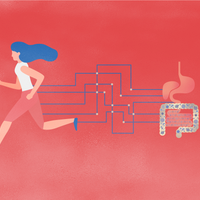ABOVE: THE SCIENTIST STAFF
When Sara Campbell first typed “exercise and microbiome” into PubMed in 2010 and hit enter, “the search literally said zero,” she tells The Scientist. Campbell was just beginning an assistant professorship in exercise science at Rutgers University. Being an athlete herself and having studied cholesterol metabolism and exercise and diet during her PhD and postdoc, she started to wonder if exercise could influence the microbes in the gut.
“We know that exercise does all of these incredible things,” Campbell says, such as keeping inflammation down and enhancing antioxidant defenses. And so she thought, “well, if there’s symbiosis and mutualism that go on between the host and the microbes, there has to be something going on . . . something changing about the microbes” during exercise. When her PubMed search came up empty, she decided: “I’ve got to study this.”
Teaming up with microbiologists and...
One of the leading ideas in the field of exercise’s influence on the microbiome is that working out boosts the levels of gut microbes that produce butyrate.
Published in March 2016, the results bolstered findings that came out a few years before showing that exercise prevented weight gain and altered the gut microbes in mice that became obese eating a high-fat diet. They also aligned nicely with a longitudinal study in humans published in 2018 that found lean, sedentary people who exercised for six weeks also developed higher levels of Clostridiales, Lachnospira, Roseburia, and Faecalibacterium in their guts, but those microbes returned to baseline levels when the individuals stopped exercising. Obese individuals who started exercising had changes to their gut microbes too, but those changes were different than what was seen in lean individuals.
While the reasons for the difference in changes between lean and obese individuals aren’t understood yet, the results make it clear that exercise, regardless of diet or body composition, change the gut microbiota of humans, says Jeffrey Woods, a researcher at the University of Illinois, Urbana-Champaign and a coauthor of the 2018 paper.
“This is a fairly new field in general and definitely a new field of exercise science,” he says, explaining that while the connection between exercise and gut microbe changes has been established, “how exercise changes the microbes, we do not know.” It’s also not yet clear whether the changes are beneficial to health, but there are clues that they might be.
Clues to the exercise-gut connection
One of the leading ideas in the field of exercise’s influence on the microbiome is that working out boosts the levels of gut microbes that produce butyrate—a short chain fatty acid that has a whole host of health benefits in humans, from producing satiety hormones that curb hunger to playing a role in supporting the survival of existing neurons and promoting the growth of new ones.
See “The Microbiome and Human Health”
Faecalibacterium, along with other bacteria, such as Lachnospiraceae, that appear to increase in abundance in the gut after exercise, typically produce short chain fatty acids in response to the digestion of dietary fiber. In a review of animal and human experiments on physical activity and gut microbiome composition published in Exercise and Sport Science Reviews in April, Woods and colleagues propose that exercise might alter the gene expression of immune cells in the tissues of the gut, leading to the production of fewer pro-inflammatory cell-signaling proteins and more anti-inflammatory ones, as well as antioxidant enzymes. The immune cells sit near the microbial communities in the gut and could produce antimicrobial compounds that tamp down certain taxa while bolstering the growth of butyrate-producing bacteria. Exercise might also change the composition of mucus in the gut, which would affect bacterial species that live there, such as Akkermansia muciniphila—a bacterium with anti-inflammatory properties that appears to increase in abundance in response to exercise.
See “Commensal Bacterium Reduces ALS Symptoms in Mice”
Exercise also raises a person’s core temperature and reduces blood flow to the intestines, which could lead to more direct contact between gut microbes and immune cells in the mucus of the gut—and has the potential to shift microbial composition. The circulation of bile acids, which can alter the microbial community of the gut, also increases during exercise, as does lactate, which might change the pH of the gut, shifting the diversity of the microbial community. “Those are some possible mechanisms we could test,” Woods says, “but they are not easy to test because it’s hard to isolate any one of them.”
Exercise, microbes, and bowel health
These potential mechanisms help explain some connections scientists have observed between the microbiome and bowel health. For example, colorectal cancer patients have a reduced abundance of butyrate-producing bacteria such as Roseburia and Lachnospiraceae. Butyrate in healthy cells spurs epigenetic modifications that lead to cell turnover and cell proliferation, while in colon cancer cells the fatty acids work through epigenetics to suppress cell proliferation and promote cell death, suggesting a benefit to colon cancer patients who exercise.
To measure the benefit of exercise against inflammation in the gut, Woods and colleagues performed the first exercise fecal microbiome transplant in mice and published the results in 2017. They took fecal matter from mice that exercised and those that didn’t and transferred the material into germ-free mice. Then, once the microbiota had established itself in the recipients, the team gave the animals’ drugs, inducing extreme inflammation in the colon. Mice that received gut microbes from active donors loss less body weight and had fewer symptoms of inflammatory disease compared with mice that received microbes from sedentary animals. Whether a similar protocol could help people suffering from irritable bowel syndrome—marked by persistent inflammation—remains to be tested.
A separate team of researchers also used a fecal microbiome transplant to test its effect on obesity. In a study published last October, they report that transplanting fecal matter from mice that exercised into obese mice fed a high-fat diet led to weight loss, reduced fasting blood glucose levels, and lower levels of pro-inflammatory cytokines in the mice receiving the transplant. The results, the researchers note, suggest that a fecal microbiome transplant from donors with a balanced diet, regular exercise, or, in the best-case scenario, a combination of both, could help ease the ill effects of obesity in humans.
Overweight and obese rat moms who exercise during pregnancy also transferred microbes beneficial to gut health to their babies, a recent study found. And, there’s preliminary evidence to suggest a tentative link between physical activity, gut microbes, and mental health, Campbell notes. “These correlations are out there,” she says. “The mechanisms . . . that’s what we are going to start to look at.”
Ashley Yeager is an associate editor at The Scientist. Email her at ayeager@the-scientist.com.
Interested in reading more?







